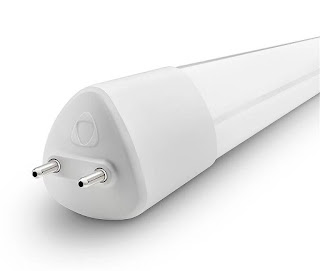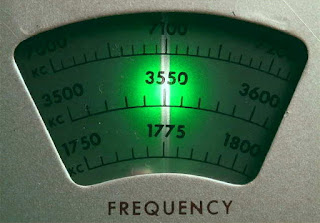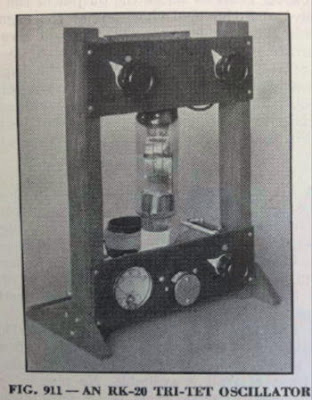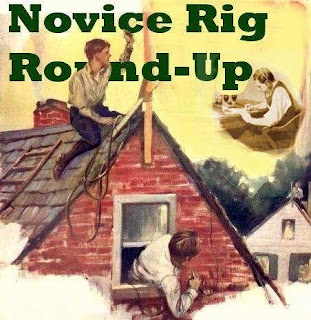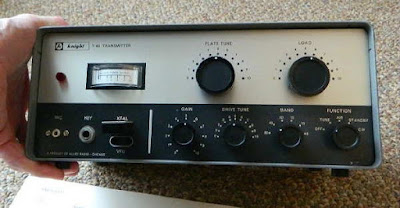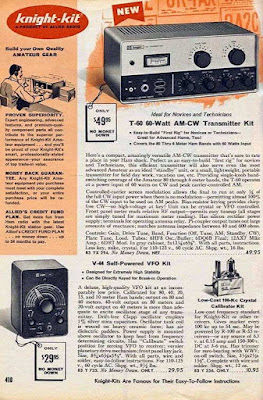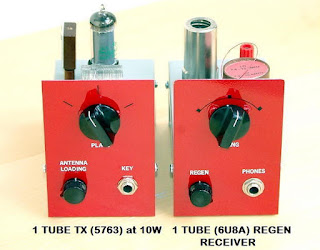Author Archive
 Hunting For NDBs In CLE267
Hunting For NDBs In CLE267
| YUT - Replulse Bay, NU (courtesy: ve3gop.com) |
Propagation on MF has been both hot and cold for the past few weeks, seemingly depending on where you live and the amount of geomagnetic activity affecting your region. As well, the Sun has been throwing a lot of Coronal Hole Streams toward earth which may or may not affect this weekend's propagation ... but this is all part of the radio-magic fun.
A 'challenge target' for listeners in North America is YUT - 335kHz in Repulse Bay, NU, at the north end of Hudson Bay. Even though running just 25 watts, it's widely heard throughout North America and Europe and is a good target for listeners everywhere. Listen for YUT's upper sideband on 335.406 kHz.
When tuning for NDBs, put your receiver in the CW mode and listen for the NDB's CW identifier, repeated every few seconds. Listen for U.S. NDB identifiers approximately 1 kHz higher or lower than the published transmitted frequency since these beacons are modulated with a 1020 Hz tone approximately.
For example, 'AA' near Fargo, ND, transmits on 365 kHz and its upper sideband CW identifier is tuned at 366.025 kHz while its lower sideband CW ident can be tuned at 363.946 kHz. Its USB tone is actually 1025 Hz while its LSB tone is 1054 Hz.
Often, one sideband will be much stronger than the other so if you don't hear the first one, try listening on the other sideband.
Canadian NDBs normally have an USB tone only, usually very close to 400 Hz. They also have a long dash (keydown) following the CW identifier.
All NDBs heard in North America will be listed in the RNA database (updated daily) while those heard in Europe may be found in the REU database. Beacons heard outside of these regions will be found in the RWW database. These databases have recently been re-vamped and are slicker than ever before!
From CLE coordinator Brian Keyte (G3SIA), comes the following CLE info:
Hello all
Here are the full details for this weekend's co-ordinated listening event.
It is open to everyone including CLE new-comers:
Days: Friday 23 April - Monday 26 April
Times: Start and end at midday, your LOCAL time
Range: 335.0 - 349.9 kHz
Wherever you are, please join us and log the NDBs that you can positivelyidentify that are listed in this busy frequency range (it includes 335.0 kHz but not 350 kHz) plus any UNIDs that you come across there.
Very short logs and very long ones are welcome (in-between ones are OK too!)
Send your CLE log to the List, preferably as a plain text email (not in an attachment) with ‘CLE267 FINAL’ in its subject line.
Please show on EVERY LINE of your log:
# The date (e.g. '2021-04-23' or just the day no. '23') and UTC (the day changes at 00:00 UTC).
# kHz (the beacon's nominal published frequency, if you know it)
# The Call Ident.
Show those main items FIRST on each line, before other optional details such as Location, Distance, etc. If you send any interim logs to the List during the event, please also send your 'FINAL', complete one.
Always make your log interesting to everyone by giving details of the listening location and brief details of the receiver, aerial(s), etc.,that you were using.
We will send the usual 'Any More Logs?' email at about 19:00 UTC on Tuesday so that you can check that your log has been found OK.
Do make sure that your log has arrived on the List at the very latest by 08:00 UTC on Wednesday 28 April. Joachim and I will then hope to complete making the combined results within a day or two.
You can check on all CLE-related information from the CLE Page
http://www.ndblist.info/cle.htm
It includes a link to seeklists for the Event from the Rxx Database.
Good listening
Brian
-----------------------------------------------------------------------
From: Brian Keyte G3SIA ndbcle'at'gmail.com
Location: Surrey, SE England (CLE coordinator)
-----------------------------------------------------------------------
(REMINDER: You could use any one remote receiver for your loggings,
stating the location and owner - with their permission if required.
A remote listener may NOT also use another receiver, whether local
or remote, to make further loggings for the same CLE).
If you are interested in some remote listening - maybe due to local difficulties - you could use any one remote receiver for your loggings, stating its location and with the owner's permission if required.( e.g. see kiwisdr.com ) A remote listener may NOT also use another receiver, local or remote, to make more loggings for the same CLE.
These listening events serve several purposes. They
• determine, worldwide, which beacons are out-of-service or have gone silent since the last CLE covering this range
• will indicate the state of propagation conditions at the various participant locations
• will give you an indication of how well your LF/MF receiving system is working
• give participants a fun yet challenging activity to keep their listening skills honed
Final details can be found at the NDB List website, and worldwide results, for every participant, will be posted there a few days after the event.
The NDB List Group is a great place to learn more about the 'Art of NDB DXing' or to meet other DXers in your region. There is a lot of good information available there and new members are always very welcome. As well, you can follow the results of other CLE participants from night to night as propagation is always an active topic of discussion.
You need not be an NDB List member to participate in the CLEs and all reports, no matter how small, are of much value to the organizers.
Remember - 'First-time' logs are always VERY welcome!
Reports may be sent to the NDB List Group or e-mailed to CLE co-ordinator, Brian Keyte (G3SIA), whose address appears above. If you are a member of the group, all final results will also be e-mailed and posted there.
Please ... give the CLE a try ... then let us know what NDB's can be heard from your location! Your report can then be added to the worldwide database to help keep it up-to-date.
Have fun and good hunting!
 An RF-Quiet LED ‘Fluorescent’ Bulb
An RF-Quiet LED ‘Fluorescent’ Bulb
I recently had the fluorescent bulb in one section of the under-cabinet kitchen counter lighting fixture go dark. This wasn’t too surprising as the 24” bulb had been in place since the house was built in 1990!
 |
 Hunting For NDBs In CLE266
Hunting For NDBs In CLE266
Propagation on MF has been both hot and cold for the past few weeks, seemingly depending on where you live and the amount of geomagnetic activity affecting your region.
A 'challenge target' for listeners in North America is YZS - 362kHz in Coral Harbour, NU, on Southampton Island at the north end of Hudson Bay. It's widely heard throughout North America and Europe and is a good target for listeners everywhere. Listen for YZS's upper sideband on 362.405 kHz.
When tuning for NDBs, put your receiver in the CW mode and listen for the NDB's CW identifier, repeated every few seconds. Listen for U.S. NDB identifiers approximately 1 kHz higher or lower than the published transmitted frequency since these beacons are modulated with a 1020 Hz tone approximately.
For example, 'AA' near Fargo, ND, transmits on 365 kHz and its upper sideband CW identifier is tuned at 366.025 kHz while its lower sideband CW ident can be tuned at 363.946 kHz. Its USB tone is actually 1025 Hz while its LSB tone is 1054 Hz.
Often, one sideband will be much stronger than the other so if you don't hear the first one, try listening on the other sideband.
Canadian NDBs normally have an USB tone only, usually very close to 400 Hz. They also have a long dash (keydown) following the CW identifier.
All NDBs heard in North America will be listed in the RNA database (updated daily) while those heard in Europe may be found in the REU database. Beacons heard outside of these regions will be found in the RWW database. These databases have recently been re-vamped and are slicker than ever before!
From CLE coordinator Brian Keyte (G3SIA), comes the following CLE info:
Hello all
Our 266th Co-ordinated Listening Event is almost here.
Can new 'listening eventers' join in too? YES, PLEASE!
Joachim and I are always pleased to help first-time CLE logs
through the harvester program.
Days: Friday 26 March - Monday 29 March
Times: Start and End at midday, your LOCAL time
Range: 350.0 - 369.9 kHz
Please log all the NDBs you can identify that are listed in this range (it includes 350 kHz but not 370) plus any UNIDs that you come across there.
You can find full information to help you, including seeklists made from
REU/RNA/RWW, by going to the CLE page http://www.ndblist.info/cle.htm and clicking on CLE SEEKLIST there.
Please send your 'Final' CLE log to the List, if possible as a plain text
email and not in an attachment and - important - with 'CLE266' and 'FINAL'
in its title.
Please show the following main items FIRST on EVERY line of your log:
# The full Date (e.g. 2021-03-26) or just the day (e.g. 26)
and UTC (the day changes at 00:00 UTC).
Many of us will be changing our house clocks during
the weekend, but UTC CONTINUES UNCHANGED.
# kHz - the beacon's nominal published frequency, if you know it.
# The Call Ident.
Optional details such as Location and Distance go LATER in the same line.
Please always include details of your own location and brief details of the
receiver, aerial(s) and any other equipment you were using.
Joachim or I will send the usual 'Any More Logs?' email at about 19:00 UTC
on Tuesday so you can check that your log has been found OK.
Make sure that your log has arrived at the very latest by 08:00 UTC on
Wednesday 31 March. We hope to make all the combined results within a day
or so.
Good listening
Brian
-------------------------------------------------------------------
From: Brian Keyte G3SIA ndbcle'at'gmail.com
Location: Surrey, SE England (CLE coordinator)
-------------------------------------------------------------------
If you are interested in some remote listening - maybe due to local difficulties - you could use any one remote receiver for your loggings, stating its location and with the owner's permission if required.( e.g. see kiwisdr.com ) A remote listener may NOT also use another receiver, local or remote, to make more loggings for the same CLE.
These listening events serve several purposes. They
• determine, worldwide, which beacons are out-of-service or have gone silent since the last CLE covering this range
• will indicate the state of propagation conditions at the various participant locations
• will give you an indication of how well your LF/MF receiving system is working
• give participants a fun yet challenging activity to keep their listening skills honed
Final details can be found at the NDB List website, and worldwide results, for every participant, will be posted there a few days after the event.
The NDB List Group is a great place to learn more about the 'Art of NDB DXing' or to meet other DXers in your region. There is a lot of good information available there and new members are always very welcome. As well, you can follow the results of other CLE participants from night to night as propagation is always an active topic of discussion.
You need not be an NDB List member to participate in the CLEs and all reports, no matter how small, are of much value to the organizers.
Remember - 'First-time' logs are always VERY welcome!
Reports may be sent to the NDB List Group or e-mailed to CLE co-ordinator, Brian Keyte (G3SIA), whose address appears above. If you are a member of the group, all final results will also be e-mailed and posted there.
Please ... give the CLE a try ... then let us know what NDB's can be heard from your location! Your report can then be added to the worldwide database to help keep it up-to-date.
Have fun and good hunting!
 My 2021 Novice Rig Roundup Summary
My 2021 Novice Rig Roundup Summary
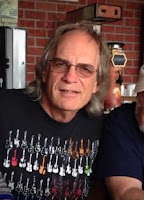 |
| Bry - AF4K (SK) |
Missing for the first time was NRR co-founder, Bry Carling, AF4K, who sadly became a silent key last year. I missed hearing him and always looked forward to the challenge of making it down to Florida from here. This year''s NRR was dedicated to AF4K - RIP Bry.
Some of this year’s excitement included the much better conditions on 15m over the previous solar-low years. The band benefited from an increase in the solar flux at the beginning of the week which kept the MUF a little higher than 21MHz for most of the Roundup.
It was particularly exciting to hook-up with VA1RST way back in Nova Scotia, on 15m. His little DX-60 did a good job in making the coast-to-coast leap at 559.
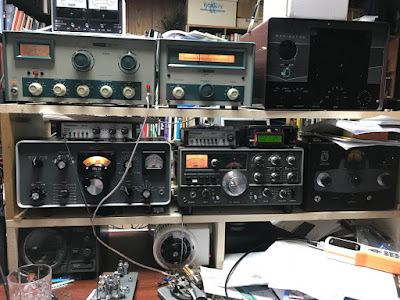 |
| VA1RST in Nova Scotia |
I think this year I heard more DX-60s than ever before! A couple of years ago it was the Knight T-60 that seemed to be everywhere. Don’t pass up either of these fine NRR rigs should you be fortunate enough to run across one.
All told, I completed 26 NRR contacts on 15m which surely is good news for future NRRs going into Cycle 25. If the bold predictions for the new cycle come to fruition, we may be enjoying 10m next time out as well!
My first contact on 15m was with Mike, WA5POK in TN, who came blasting through at 599 with his DX-40 only to have the power transformer in his National NC-270 go up in smoke a few days later. Such are the perils of living life on the edge, in the NRR!
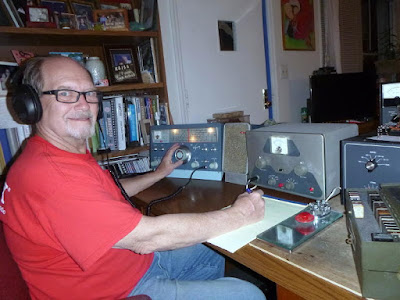 |
| Mike - WA5POK in Tennessee |
I was lucky enough to snag Rich, WB2WGX in NY on 15m for his only contact on that band! I'm not sure why he didn't find more action as his Ranger II was 599 here on the west coast.
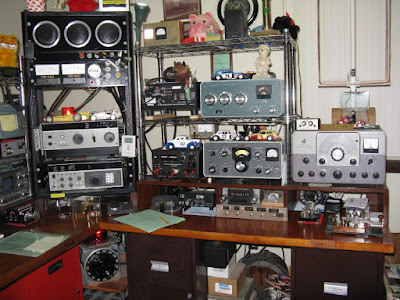 |
| WB2WGX in New York |
Worked on both 40 and 15m was Paul, WB5EVO in OK. Putting yet another DX-60 into the log with the notation of "599+"!
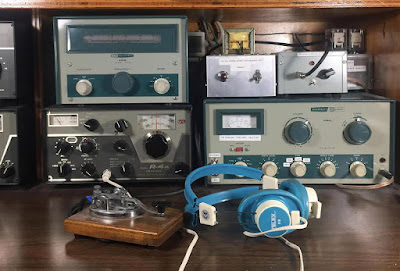 |
| WB5EVO in Oklahoma |
What would 15m be without a little DX? I was delighted to hear Jorge, KP4GC in PR, reply to my CQ to the south east. Jorge was heard working stations from coast to coast but may have also been living too close to the NRR edge as the bias supply in his Hallicrafters HT-37 took him off the air until he set up his Kenwood TS-520 for the duration.
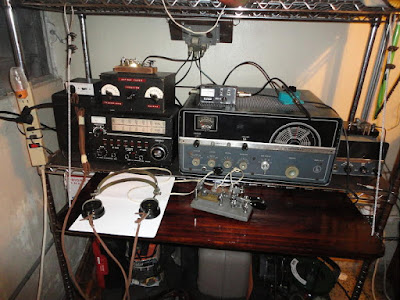 |
| KP4GC in Puerto Rico |
Another duo-band contact (40 & 15m) was with Dan, K2YWE in MD whose Globe Scout was also 599, three S-units louder than on 40m.
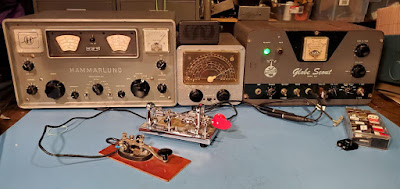 |
| K2YWE in Maryland |
Although 15m provided a lot of excitement, most of my contacts were on 40m. Number 1 on the runway again this year was NRR regular, WB2AWQ down in Reno. Howie's fine homebrew parallel 807s were smoking-in up here, delightfully chirpy, in broad daylight.
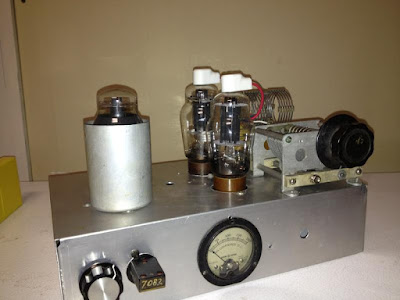 |
| WB2AWQ in Nevada |
George, KA3JWJ in PA impressed again this year on 40m when his original Ameco AC-1 at 8W pushed the S-meter on my FT-1000 to S7.5! How do you do it George? Don't be fooled by that innocent-looking box sitting atop his S-38 inhaler, also used during our QSO. I thought our contact would likely hold up as the contest highlight for me, until later ...
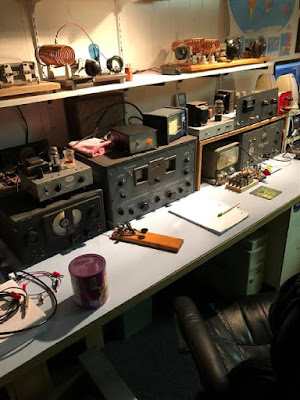 |
| KA3JWJ in Pennsylvania |
WB2QLL, Pete in WI, surprised me on 80m with a ‘never before heard’ (by me) Harvey Wells TBS-50D Bandmaster at 20W out. These once popular transmitters promised buyers 80 - 2m operation, push-pull 6L6 plate modulation and a sturdy 807 final.
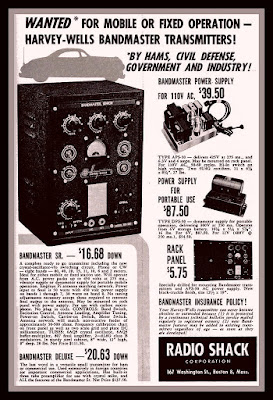 |
| Harvey-Wells 'Bandmasters' |
This was another contest highlight for sure, as I’ve always wondered how these rigs sounded on CW ... and Pete’s signal did not disappoint! It definitely has an identifiable sound.
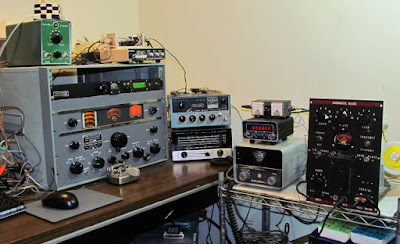 |
| W2QLL in Wisconsin |
Many of you worked NRR devotee VA7MM, whose 100’ high dipoles and DX-60 swept-up an impressive 146 contacts. Well done Mark!
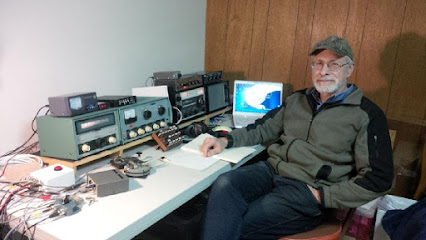 |
| Mark - VA7MM in British Columbia |
Not too far from him was another Mark from BC, VE7CA, who ran his rebuilt Ranger and much-modified HQ-120 on the low bands while his beautiful Drake twins carried the mail on 15m. His well-performing all-wire arrays are supported by a handy selection of tall backyard Firs.
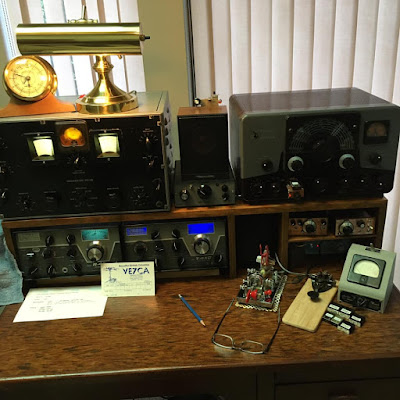 |
| VE7CA in British Columbia |
'579' reports were exchanged on 80m with Tim, K9SB in IL, who was using a Johnson Adventurer and Hallicrafters SX-101A.
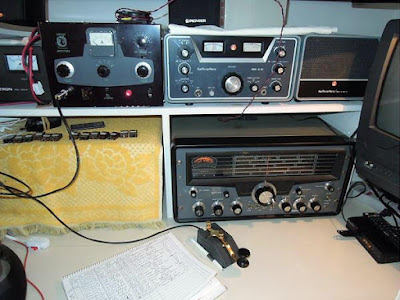 |
| K9SB in Illinois |
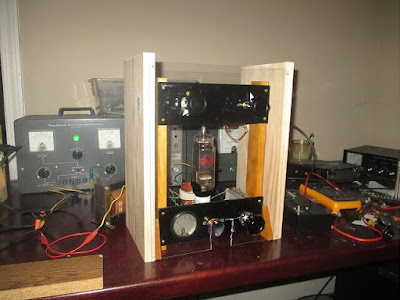 |
| KØSM's '36 Tri-Tet |
Andy's Tri-Tet runs at 400V on the plate, unlike the original design that called for 1kV on the plate and bare tank coil. Now that's really operating on the scary edge! At 8W output on 80 and 40, there's plenty of power to work with.
But it wasn’t just working Andy on 80 and 40 that made it so special as Andy later, tripling from 40, finessed this little beast up to the 15m ultra-highs, making it to the west coast in fine shape. It was delightful to hear the '36 Tri-Tet's charming chirp on a band that didn’t even exist when this rig was first thought of. Thanks for the fun Andy!
 |
| Andy - KØSM in New York |
For many more station photos and 'soapbox' comments from this year's participants, be sure to visit the NRR Soapbox page and ... if you didn't make this year's event then now's the time to start planning for the 2022 NRR ... see you all then!
 Here Comes The 2021 Novice Rig Roundup (NRR)!
Here Comes The 2021 Novice Rig Roundup (NRR)!
One of the most enjoyable operating events of the year is fast approaching -- the Novice Rig Roundup or 'NRR'. This year, the activity is dedicated to NRR founder and long-time participant, Bry, AF4K, who sadly became a silent-key last year.
 |
| Bry - AF4K |
Technically, the NRR is a contest, but I have the feeling that most participants think of it as just a lot of fun and a nice opportunity to hear and work some of the great old 'classics' of the past -- rigs that were used when they were teenage Novices or rigs that they could only drool about owning, back in those formative years when they each discovered the magic of radio.
The dates to remember are 0000 UTC March 6 to 2359 UTC March 14 and this multi-day opportunity is, for me, what makes the NRR so enjoyable. With a nice diversion from the usual 'contest frenzy' associated with standard weekend operating events, the NRR can be enjoyed throughout the week, whenever you choose to participate. If last year's operating patterns continue, you should find activity at any time of the day ... and even more as sunset arrives.
With the early growth of Cycle 25, we will likely be treated to some transcon opportunities on 15m or even 10m, as many 15m transcon contacts were made during last year's event thanks to some well-timed solar activity!
Although technically not required, if you plan to participate it's best to obtain your own NRR number, which is an easy 30-second process.
Additionally, there is an online logger where participants can post their daily log. The nifty logger also keeps track and figures out your score as it goes and no 'after contest' log needs to be submitted. If you plan on submitting a log, the logger is a requirement. The logger will also require you to set up a 'log-in' and once again, a simple 30-second process will take care of that from here. If you used the logger last year, you will have to set it up again for this year as the old system has been changed.
Stations may run either crystal-control or VFO or can switch between either method ... the online logger will keep track and score things appropriately.
All of the rules and information can be found on the NRR's excellent website. As well, the soapbox comments and station pictures from last year's NRR may provide the inspiration that you need to spark-up your own activity in this year's event ... from what I can tell, this year will be bigger and busier than ever!
There is also a dedicated NRR Group, often the source of much valuable discussion but there is a now HUGE group of great NRR chat and activity now on Facebook's NRR Group here. I avoided Facebook for many years and have now discovered that it is an excellent forum for real time chat and information exchange ... one can still choose to maintain a very low profile and avoid unwanted interaction if set up correctly.
If you have access to the web while operating, be sure to bookmark and check into the NRR's realtime chat page. Many ops that are crystal controlled will announce their operating frequencies, making it easier for you to find them ... sometimes way up or down from the normal NRR watering holes of ~ 3550 - 3650 kHz, 7100 -7125 kHz, 21.100 - 21.150 MHz and 28.114, 28.120 MHz ... and don't forget to check the colorburst crystal frequency of 3579!
'CQ'ers should always remember to tune up and down the watering hole for replies from other NRR stations that may be crystal controlled and not able to answer you on your own frequency!! This is extremely important and a real reminder of what was common practice back in the Novice days.
 |
| courtesy: Harry - VE7AIJ |
You still have time to get that old clunker on the air but if that's not possible, you can join the fun with your modern rig as well ... all are welcome to jump in and have a great week of radio-fun. I think you will be surprised, just as I was last year, how good some of these old classics can sound ... and you'll hear some great bug-fists as well.
***********************
The NRR once again provided many notable highlights over the nine day event.
Almost topping the list was just experiencing the variety of old classics and hearing how well almost all of them sounded. Numerous Knight T-60s, Drake 2NTs, Heath DX-40s, Johnson Adventurers and Eico 720s, along with a nice variety of homebrew MOPAs and one-tube power oscillators graced the nightly airwaves. These oft-forgotten shelf-queens always seem to develop super-powers, far beyond their expectations, when the NRR rolls around!
I was really surprised to work so many T-60s, a small and inexpensive 60 watt transmitter kit from 1962 using a popular 6DQ6 television sweep tube ... one never expected to achieve such RF greatness! I was very impressed with every one that I heard.
What radio-struck pre-Novice teen, dreaming about getting on the air, could resist a clever ad like this.
Scott, KA9P's 80m T-60 signal sounded as sweet as it looks in his NRR setup, paired with his Heathkit HR-10B inhaler.
 |
| KA9P NRR station with RAF Vulcan bomber Type 51 hand pump |
Right up there with the plethora of T-60s was the Drake 2NT, another great sounding radio and also my choice for this year's event. My summer refurbishing project, described here, proved a worthy companion, although my much-treasured VF-1 VFO's short term drift probably had my 2NT getting red in the face whenever I took her off of crystal control to scurry around the band, seeking out the CQ'ers. I've had a love-hate relationship with the VF-1 ever since buying my first one back in '63!
 |
| VE7SL NRR with 2NT, VF-1 and my Original '63 Vibroplex |
Yet another 2NT packed a powerful punch from West Virginia, keyed by Dave, W3NP, when we exchanged 579 reports on 40m, 45 minutes before sunset.
 | |
| W3NP - NRR setup |
 |
| K2YWE's Globe Scout and Adventurer were worked on all three bands! |
My NRR exchanges with George, N3GJ (KA3JWJ) in Pennsylvania, truly demonstrated just how well the low bands were performing. More than an hour before my local sunset, I responded to his 569 40m 'CQ NRR' only to learn that his signal, now reaching a solid 579, was coming from an original Ameco AC-1! This one-tube crystal-controlled power oscillator has, over the years, reached Holy Grail status among many amateurs. Originals are guarded like precious jewels and handed down from father to son ... or in George's case, from uncle to nephew!
 | |
| N3GJ and his all powerful original AC-1 |
I was astounded at the strength of George's signal and before exchanging '73's added 'CUL on 80', not really thinking how low the chances of that might really be. Two hours later, his even stronger 'CQ NRR' was heard on 80m, as his 579 signal flirted with reaching S8 ... all emanating from just a low hanging inverted-V. It's nights like this that remind me how I was bitten by the radio bug so many years ago and to have them coincide with the NRR was an added bonus. I've rated my contacts with George's AC-1 the highlight of this year's NRR for me!
Heathkits were plentiful too, with the DX-60 seeming to be the rig of choice, often paired with the matching HG-10 VFO. Both Mark, VA7MM and Gary, W8PU, packed a wallop with these fine examples.
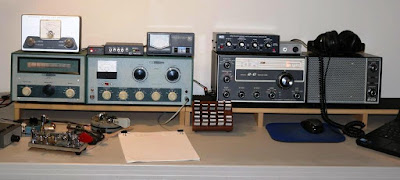 |
| VA7MM - NRR |
| W8PU - NRR set-up |
But it wasn't just DX-60s representing Benton Harbor engineering in the NRR. All of these neat old Heaths made it out to the west coast, sometimes on both 40 and 80. KN8RHM's (Rick) HW-16 made it here on 40m with a solid signal almost every night, while KE4OH (Steve) sported a modernized DX-20 in the form of Heath's HX-11. Steve even received the highly-treasured 'OO' report for his NRR chirp ... good job!
| KN8RHM - HW-16 NRR set-up |
 |
| KE4OH - HX-11 NRR station |
Not to be forgotten was the ubiquitous DX-40, used by several, including this proud old warhorse, lovingly keyed by Doug, N3PDT.
| N3PDT - DX-40 NRR transmitter |
Rich, WN7NRR / AG5M operating in nearby Washington state put some of his 44 crystals to work with his HW-16 ... that's some collection!
| WN7NRR - HW-16 NTT set-up |
It seems that many NRRers are as adept with a soldering iron as they are with a hand key, as several homebrew transmitters were worked from here as well.
Howie, WB2AWQ in Reno, was using his homebrew pair of 807s, driven with a Millen 90700 swing-arm VFO from 1945. Most shacks worldwide, including the Novices, found plenty of use for the 807 as they were dirt-cheap in the post war surplus market. The filament has a beautiful illumination and if a bit gassy as most are by now, emit a wonderous blue glow with each press of the key.
 |
| WB2AWQ - 807s |
| KD7JG's 1625 NRR mainstay |
K4IBZ down in Florida also utilized the magical 6DQ6 sweep tube in his homebrew rig for 80 and 40m. Bill was worked on both bands from here with his 10 watts receiving a 569 on both contacts.
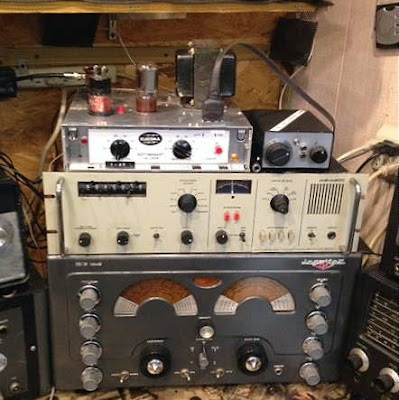 |
| K4IBZ's 10 watter |
AA8V, Greg in Maryland, used an LM-13 war surplus frequency meter to drive a popular Novice pairing of the 6AG7 / 6146 at 90W input ... good enough for a 579 report on 40m, 30 minutes before my sunset.
 |
| AA8V's homebrew NRR stack |
 |
| VE3BDV / VE3AWA - 50C5 Bare - Essentials power oscillator |
As indicated on the NRR website, this is "more of an EVENT than just a typical contest ... once again taking our OLD ham radios off the shelf and putting them to use again! "
 Hunting For NDBs In CLE265
Hunting For NDBs In CLE265
 |
WC - 332 White Rock, BC |
For example, 'AA' near Fargo, ND, transmits on 365 kHz and its upper sideband CW identifier is tuned at 366.025 kHz while its lower sideband CW ident can be tuned at 363.946 kHz. Its USB tone is actually 1025 Hz while its LSB tone is 1054 Hz.
Often, one sideband will be much stronger than the other so if you don't hear the first one, try listening on the other sideband.
Canadian NDBs normally have an USB tone only, usually very close to 400 Hz. They also have a long dash (keydown) following the CW identifier.
All NDBs heard in North America will be listed in the RNA database (updated daily) while those heard in Europe may be found in the REU database. Beacons heard outside of these regions will be found in the RWW database. These databases have recently been re-vamped and are slicker than ever before!
From CLE coordinator Brian Keyte (G3SIA), comes the following CLE info:
Hello all
We have something special for our 265th Listening Event, now less than a week away.Days: Friday 19 February - Monday 22 February
Times: Start and End at midday, your LOCAL time
It is just 20 years since fully-organised CLEs started. Encouraged by Alan, to mark the anniversary Joachim and I have five separate, new, and mostly gentle ‘Challenges’ for you!
They are all based of ’20-ness’. Whether you have enjoyed 20 years of our CLEs, or are thinking of trying your very first, this CLE should be a good one.
CHALLENGE 1. 20 NDBs ( N ) Log any 20 NDBs located in any ONE RADIO COUNTRY of your choice.
CHALLENGE 2. 20 Radio Countries ( C ) Try to log ONE NDB from each of:
listeners in Europe: 20 different EU radio countries
listeners in N America: 20 different USA/CAN States/Provinces
listeners elsewhere: 20 different radio countries
CHALLENGE 3. 20 re-logged OLD NDBs ( O ) Try to log any 20 of the NDBs that were also logged in our first formal Event - CLE003, 20 years ago.
In the Final Details a list will be provided of the 80 CLE003 loggings of NDBs in Europe and N America that are still probably active.
CHALLENGE 4. 20 ‘n20 kHz’ loggings ( K ) Try to Log a total of 20 NDBs on the ‘n20’ kHz frequencies
i.e. on 220 kHz and 320 kHz and 420 kHz and 520 .. . . up to 1220 kHz (as possible!)
(The other four challenges can use the whole NDBs frequency range)
CHALLENGE 5. 20 loggings at 20:-- hrs ( H ) Log a total of 20 NDBs between 20:00 and 20:59 LOCAL time during the CLE.
(If you find the challenges a bit too gentle, there will be an alternative hard version of this 5th one.
We will explain in the Final Details)
How will you set about tackling those different kinds of listening? Some ways are good, others not-so-good, perhaps prompting some questions from you!
About two days before the start, the Final Details will have some answers and suggestions and full advice on tackling your listening and log-making.
So the Final Details will explain how one logging CAN satisfy more than one Challenge without any problems, but, as always, each NDB must appear only once in a CLE log.
(If you are interested in what was going on 20 years ago I’ve added a short ‘Background for Historians’ below)
Background for Historians!
Alan Gale still has archive information about what was going on 20 years ago.
At that time several of us were thinking about trying out some coordinated listening.
For example, early in 2001 Bill Hohnstein wrote “What would seem interesting to me would be to have a weekend (certain days) where ndblist would sponsor concentrated monitoring of a 10 – 20 kHz segment of the LF NDB range with everyone reporting their results” and Lionel Roithmeir organised an event for 2182 kHz monitoring. Andy Robins, Michael Oexner, Morris Sorensen, Kathleen Redding, Brian Keyte and others contributed further ideas.
We were talking about ‘Coordinated Monitoring Events’ or CMEs.
We had an informal ‘CME’ on 20-21 January listening on 380-400 kHz. There were logs from Alan, Kathleen and Brian (all ENG), Roger Caird (IRL), Andy, Bill, Dave Tomasko, Douglas Klein, Ken Zichi and Phil Atchley (all USA), and Morris (CAN)
Phil rescued us from the ‘CME problem’! He wrote “I have one big suggestion. Let's change the name from CME to CLE, Coordinated Listening Event". Every time I see CME in a message subject line I think a CME "Coronal Mass Ejection" has just taken place.”
Then on 3-4 February we were also joined by Bo Nenson (SWE), Christoph Mayer and Norbert Reiner (both DEU), Lionel and Mike Trodd (both ENG), Bob Parsons and Chris Steele (both USA) for a second informal Event which we called a ‘CLE’.
|
|
Michael Oexner, Roschbach | Morris Sorensen, Winnipeg |
Jean Jacquemin, Merville | Rodney Valdron, New Brunswick |
Pat Vignoud, SE France | Phil Atchley, Merced, Central CA |
Tore Ekblom, Nr Helsinki | Dave Tomasko, Chicago |
Lionel Roithmeir, Guernsey | Andrew Robins, Kalamazoo |
Alan Gale, Lancashire | Doug Klein, Hastings |
Brian Keyte, mid Surrey | Bill Hohnstein, Nr Lincoln |
Kathleen Redding, NE London | Bob Parsons, Gloucester City, NJ |
Mike Trott, W. Sussex | Jack Woods, Oregon |
Robert Connolly, Kilkeel | Chris Steele, while at Ft Worth |
Costas Krallis, Athens |
|
Roger Caird, Dublin |
|
Bo Nensen, Ornskoldsvik |
|
Good listening
Brian & Joachim
---------------------------------------------------------------------
From: Brian Keyte G3SIA ndbcle'at'gmail.com
Location: Surrey, SE England (CLE co-ordinator)
---------------------------------------------------------------------
If you are interested in some remote listening - maybe due to local difficulties - you could use any one remote receiver for your loggings, stating its location and with the owner's permission if required.( e.g. see kiwisdr.com ) A remote listener may NOT also use another receiver, local or remote, to make more loggings for the same CLE.
These listening events serve several purposes. They
• determine, worldwide, which beacons are out-of-service or have gone silent since the last CLE covering this range
• will indicate the state of propagation conditions at the various participant locations
• will give you an indication of how well your LF/MF receiving system is working
• give participants a fun yet challenging activity to keep their listening skills honed
Final details can be found at the NDB List website, and worldwide results, for every participant, will be posted there a few days after the event.
The NDB List Group is a great place to learn more about the 'Art of NDB DXing' or to meet other DXers in your region. There is a lot of good information available there and new members are always very welcome. As well, you can follow the results of other CLE participants from night to night as propagation is always an active topic of discussion.
You need not be an NDB List member to participate in the CLEs and all reports, no matter how small, are of much value to the organizers.
Remember - 'First-time' logs are always VERY welcome!
Reports may be sent to the NDB List Group or e-mailed to CLE co-ordinator, Brian Keyte (G3SIA), whose address appears above. If you are a member of the group, all final results will also be e-mailed and posted there.
Please ... give the CLE a try ... then let us know what NDB's can be heard from your location! Your report can then be added to the worldwide database to help keep it up-to-date.
Have fun and good hunting!
 A 5763 Crystal Power Oscillator For the Neophyte Regen
A 5763 Crystal Power Oscillator For the Neophyte Regen
I've just added a new page to my main website, 'The VE7SL Radio Notebook' that describes the recent construction and operating adventures with the small companion transmitter built to pair with my NEOPHYTE REGEN. I may have worked several of you with the pair already and if so, many thanks. I hope to work the rest of you soon!
